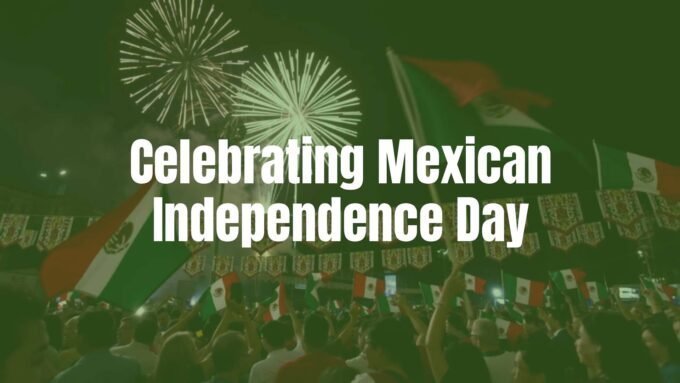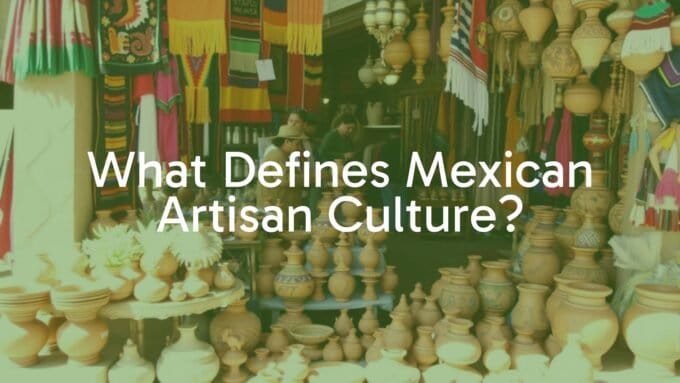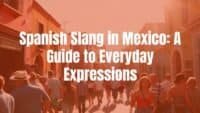Exploring Spanish slang in Mexico opens a special way of talking and connecting. It’s about more than learning vocabulary; it’s about feeling how people speak every day. Standard Spanish gives you the basics, but Mexican slang adds humor, warmth, and quick meaning that formal speech often misses. If you’re asking whether these informal phrases matter, the short answer is “¡Órale!” Mexican slang helps you have better talks, fit in faster, and enjoy a more real experience of Mexico and its people.
From casual greetings to sharp insults, slang shows daily life with color and energy. It carries history, regional style, and a shared sense of humor that makes talk lively. As you move through this way of speaking, you’ll see that many phrases don’t make sense literally, but in context they are clear to locals. Buckle up-we’re about to go through common, useful, and often funny words and phrases that shape Mexican Spanish.

What Is Spanish Slang in Mexico?
Spanish slang in Mexico is the wide mix of informal words and expressions people use in daily talk. Unlike textbook Spanish, slang changes often and connects closely with social life and culture. It’s what you hear among friends, in the street, and in everyday moments. Some slang overlaps with other countries, but many terms are uniquely Mexican and reflect its history and customs.
This informal set of words is mostly used in casual settings, often by younger people, and ranges from sweet nicknames to strong swear words. Learning it is very important if you want to go beyond basic talk and really join in Mexican life. It’s the difference between speaking Spanish and sounding Mexican.
How Is Mexican Spanish Different from Other Spanish Dialects?
Mexican Spanish (“Español mexicano”) has features that make it different from Spanish in Spain or other parts of Latin America. These differences do not stop people from understanding each other, but they do create a clear local style. Spanish arrived in Mexico in the 1500s and changed over time with influence from Indigenous languages, especially Nahuatl, and local culture.
Pronunciation stands out. In Mexico, the “s” sound is kept clear, unlike some Caribbean or southern Spanish accents where it may be softened or dropped. Mexico doesn’t use “vosotros”; people say “ustedes” for both formal and informal plural “you.” But the biggest difference-and often the most colorful-is the large and unique slang vocabulary, which is our focus here.
Why Does Slang Play a Major Role in Mexican Speech?
Slang is a big part of Mexican speech because it carries identity, feelings, and social ties. It keeps talk friendly and real. Without slang, many chats would feel stiff and too formal, missing the warmth and wit people expect.
Slang shows up everywhere, and many words change meaning with tone and context, adding depth that delights people who learn it well. It helps express surprise, love, anger, or disapproval fast and clearly. It also signals belonging-being able to use and understand slang shows cultural connection and helps build stronger relationships with Mexicans at home and abroad.
Why Is Mexican Slang Important to Everyday Life?
Mexican slang isn’t just a set of casual words; it’s a key part of daily life. It helps people connect, express who they are, and add flavor to talk. If you try to get local jokes or the feeling behind small talk without slang, you’ll miss a lot. Slang creates closeness and ease that formal language can’t match.
It also acts like a cultural shortcut. It helps you handle daily tasks, from ordering food to understanding jokes, and it helps you enjoy Mexican music and TV more. Every slang word you learn is another step toward Mexico’s rich, lively culture.
How Does Slang Reflect Mexican Culture and Identity?
Slang mirrors Mexican history, humor, values, and social life. Many words come from Indigenous languages, especially Nahuatl, showing strong roots before Spanish rule. Others grew out of historical events, social changes, or daily experiences and now fit daily life well.
For example, “no manches” (a softer version of “no mames”) shows a tendency to soften rough talk, or at least to move along a scale of politeness. Playful, self-mocking humor and many ways to label people or groups show the value placed on wit and relationships. Slang also marks regions; Mexico City terms differ from those in the north or south, creating a verbal map of the country. Slang is a living part of what it means to be Mexican.
When Should You Use Slang (and When Not To)?
Using slang well takes social awareness. It can build closeness, but misuse can cause awkward moments or offense. In general, slang fits informal situations with friends, peers, and family. With people you know well and who share your context, slang creates quick rapport and makes talk feel natural.
Be careful in formal settings or with strangers, elders, or people in authority. Heavy slang with a boss, a police officer, or someone you just met can sound rude. For example, “güey” is normal among friends, but using it with a stranger can sound sarcastic or insulting if the tone is wrong. Also, a term that’s fine in one region can offend in another. Watch and listen to how locals speak, and if you’re unsure, choose more formal language. It’s safer to sound a bit formal than to upset someone.
Regional Slang Differences Within Mexico
Mexico is large and varied, and so is its slang. A phrase common in one state may be unknown or mean something else in another. These differences reflect the country’s geography, history, and local customs and add charm to Mexican Spanish. Knowing them helps travelers and learners go deeper and connect locally. From the big capital to the dry north and the lush south, each area adds its own flavor to slang.
Words Unique to Mexico City (Chilango)
Mexico City, often called D.F. by locals, is a mix of people and speech. Residents-born or adopted-are “chilangos,” and they use a distinct set of slang terms. “Chale” is a common interjection for disappointment, like “bummer” or “dang.” “Depa,” short for “departamento,” means apartment-very fitting in a city of apartment life.
New expressions appear often, but some words are now classic signs of chilango talk. These terms help people in the city communicate quickly and also mark the culture of a massive urban center.
Border, Northern, and Southern Mexico Slang
In the north, especially near the U.S. border, English influence shows up. “Vato” means “guy” and is common, if a bit rough. “Paisa” (from “paisano”) means “countryman,” often used by Mexican-Americans and border residents. Speed bumps called “topes” in most of Mexico may be “tumolos” or “reductores” up north, and in some Latin American places “policías muertos” (dead police), adding humor to the idea.
In the south, with strong Indigenous roots, Spanish shows more influence from local languages. While details here are brief, the pattern is clear: southern speech often carries more Indigenous vocabulary. These regional layers reward anyone who spends time locally and listens closely.

Common Greetings and Expressions in Mexican Spanish Slang
In Mexico, “Buenos días” and “Hola” are just the start. Informal greetings and expressions are everywhere, and they help you sound local and connect fast. Many have several meanings, depending on tone and context, which makes them very useful day to day. Learning them will make your talks smoother and help you get the casual, friendly, and witty style people use.
Que onda, Que tal, and ¿Qué pasó?
These three are go-to informal greetings, all roughly meaning “What’s up?” or “How’s it going?”
- ¿Qué onda?: Maybe the most common and casual “What’s up?” Literally “What wave?”, it checks the vibe. “Buena onda” means cool; “mala onda” means not cool. You may hear “¡Oye, güey, ¿qué onda?!” Variants include “¿Qué tranza?” or the vulgar “¿Qué pedo?” Tone can also show surprise.
- ¿Qué tal?: A friendly, slightly more polite “How’s it going?” Still casual, and very common.
- ¿Qué pasó?: Another way to say “What’s up?” or “What’s going on?”
All three are informal. “¿Qué onda?” is probably the most common and flexible. Tone matters a lot: said warmly, it’s friendly; said with a hard tone and a gesture, it can sound aggressive.
Ahorita, Órale, and Ándale
These words come up all the time and carry a lot of meaning. They can show urgency, agreement, or flexible timing.
- Ahorita: A small form of “ahora” (now), but its meaning is very flexible: “soon,” “in a bit,” “later,” or sometimes “not going to happen.” If someone says “ahorita,” it could be five minutes, five hours, or never. It reflects a relaxed sense of time.
- Órale: A very flexible exclamation: “Go for it!”, “OK!”, “Let’s go!”, “Wow!”, “Fine!”, “Yes!”, and more. It can show excitement, approval, or urge someone on. Mexican Americans often say “órale vato.”
- Ándale: Known from Speedy Gonzales, it means “Come on!” or “Hurry up!” It can also show surprise, agreement, or “exactly,” depending on tone. “¡Ándale! Se nos va a hacer tarde” (Hurry up, we’ll be late). “¡Ándale! Te lo dije” (I told you so!).
These words are part of everyday talk. Learning their flexible meanings will help a lot with understanding and make your speech feel more natural.
Mande and ¿Neta?
These two show both politeness and directness in Mexican speech.
- ¿Mande?: The Mexican way to say “What?” when you didn’t hear or to invite someone to speak, like “Go ahead.” It sounds polite, especially with elders or authority. If your mom calls, “¡Mande!” is more respectful than “¡Qué!”
- ¿Neta?: Means “Really?” or “For real?” Used to ask for confirmation or show surprise. “La neta” means “the truth,” and “¡Eres la neta!” means “You’re the best!” Another way to say “Really?” is “¿apoco?”
“¿Mande?” leans polite; “¿Neta?” is direct. Both are very common.
¡No manches! and ¡Aguas!
These exclamations show strong reactions and warnings.
- ¡No manches!: A mild version of the vulgar “no mames.” Use it for surprise, disbelief, anger, or amazement. It can mean “No way!”, “Come on!”, or “You’re kidding!” “¡No manches, ganamos el partido!”
- ¡Aguas!: Despite literally meaning “waters,” it’s a warning: “Careful!” or “Watch out!” It likely comes from people tossing dirty water into the street and warning others. “¡Aguas con los perros!” (Watch out for the dogs.)
Both are everyday phrases for reacting fast and warning with local style.
Frequently Used Slang Words in Mexico
Beyond greetings, many single words color daily talk. They label people, things, situations, and ideas-often with humor and cultural flavor. Knowing them helps you follow jokes and casual talk.
Wey / Güey
“Wey” (or “güey”) may be the core word of Mexican slang. Pronounced like English “whey,” it changes meaning with tone and context.
Most of the time, it means “dude,” “bro,” or “pal,” used constantly among friends: “¡Oye, güey, vamos a comer!” It can also mean someone is silly: “¡Qué güey estás!” If said angrily, it can mean “idiot.” It’s used by men and, increasingly, by women with friends. Avoid it with strangers and in formal settings, or it can sound rude. Learn by listening first.
Chido and Padre
Use these when something is cool or great.
- Chido: “Cool,” “awesome,” “nice.” Works for things, situations, and people. “¡Qué chido tu coche!” “La película estuvo muy chida.” With people, it can mean cool personality or even attractive in some contexts.
- Padre: Literally “father,” but as slang means “cool” or “great,” usually for things or situations (not people). “¡Qué padre!” “Tu casa está muy padre.” The superlative is “padrísimo/a.”
Both are handy to show enthusiasm.
Pedo and its Different Meanings
“Pedo” literally means “fart,” but in slang it covers many ideas: being drunk, a problem, a greeting, and more. It’s key to street talk.
Common uses:
- A Fart: Literal meaning. “Echarse un pedo.”
- Drunk/Intoxicated: “Estoy pedo” (I’m drunk). “Ponerse pedo” (to get drunk).
- Problem/Issue: “No hay pedo” (no problem). “Ni pedo” (oh well). “Traer un pedo” (to have an issue). “¿Cuál es tu pinche pedo?” (What’s your problem?). A “pedero” causes trouble.
- Greeting/What’s Up?: “¿Qué pedo?” can mean “What’s up?” or “What the hell?” depending on tone. Softer option: “¿Qué pex?”
- Other Meanings: “Buen pedo” (nice), “mal pedo” (that’s bad/mean), “hacerla de pedo” (make a fuss), “bajarle a tu pedo” (chill), “agarrar el pedo” (understand).
“Pedo” is very common but often considered coarse. Use it only in very informal settings. “Pex” is a milder alternative.
Chamba and Changarro
Two common words for work and small business.
- Chamba: “Work” or “job,” often a tough one. “Tengo mucha chamba.” Verb: “chambear” (to work). A “chambeador” is hard-working.
- Changarro: A small store or restaurant, like a “mom-and-pop” shop. “Ve al changarro y checa si hay dulces.”
They reflect daily work life and local business culture.
Fresa, Naco, and Cholo
Labels for social style and subcultures.
- Fresa: “Preppy,” snobby, high-maintenance, or pretentious. “¡Qué fresa eres!” Can also describe things, like “música fresona.”
- Naco: Derogatory term for tacky, unrefined, or uneducated behavior. Close to “redneck” or “ghetto,” though not the same.
- Cholo: Refers to a Mexican hip-hop or gangster style, common in the U.S. Southwest and parts of Mexico: baggy clothes, shaved head, religious tattoos, dark shades.
Use with care; these terms carry strong social meaning.

Chavo, Chava, Morro, Morra
Casual words for young people, and sometimes for partners.
- Chavo / Chava: “Kid,” “boy/girl,” or “guy/gal.” Also used for boyfriend/girlfriend. Can imply naivety: “La neta estás chavo.”
- Morro / Morra: Similar to chavo/chava. Also common for boyfriend/girlfriend. Diminutives “morrito/morrita” add affection.
These are everyday terms for talking about youth and relationships.
Slang About People and Social Groups in Mexico
Mexican slang offers many ways to talk about people and groups-from friendly nicknames to sharp insults. These words often carry emotion and social meaning, which makes them powerful in daily speech.
Güero/a, Prieto/a, and Güera
Common terms linked to skin tone or hair color. Context matters.
- Güero/a: Light-skinned person, often blonde or with light eyes. Used casually, sometimes as a nickname. “Oye, güero, ¿ya terminaste?”
- Prieto/a: Dark-skinned person. Among friends it can be neutral, but it can also be used in a racist way. Non-native speakers should be cautious.
These terms show a direct way of describing looks that may feel too blunt in other cultures. Relationships and tone matter a lot.
Chilango, Chicano, and Chairo
Words for regional or social identity.
- Chilango: A person from Mexico City. “Los chilangos aman la comida callejera.”
- Chicano: A person of Mexican origin in the U.S., or who moved there young. Some embrace the term; others don’t.
- Chairo: An insult for a left-leaning idealist (“social justice warrior”). The right-leaning insult is “derechairo.”
These labels show the range of identities and politics in Mexican and Mexican-American communities.
La banda, Compa, and Carnal
Words for friends and close ties.
- La banda: “The crew” or group of friends.
- Compa: Short for “compadre,” used like “buddy” or “homie.”
- Carnal: A very close friend, like a brother. “Cuate” is another friendly term.
They show how friendship can feel like family in Mexico.
Naco, Fresa, and Popular Stereotypes
“Naco” and “fresa” are strong social labels tied to class, taste, and behavior.
- Naco: Low-class in attitude (not simply money), tacky, vulgar language, poor manners.
- Fresa: Snobby and pretentious, often linked to higher social class and exclusive circles.
Other labels include “chairo” (left-leaning idealist, used as an insult) and “malinchista” (someone seen as rejecting Mexican identity). These words can be funny or very cutting, and they reflect social debates and self-image.
Mexican Slang for Insults, Swearing, and Vulgar Language
Mexican Spanish has a wide set of insults and swear words. Many carry multiple meanings based on tone and context. Some are very offensive; others can be playful among close friends. Learn them to understand talk fully, but use them carefully, or avoid them if you’re unsure.
Chingar, Cabrón, and Pendejo
Three very strong and very common words with wide meaning ranges.
- Chingar: Like the English f-word in flexibility. It can mean “awesome” (“está chingón”) or “messed up” (“está de la chingada,” softer: “de la fregada”). It can also mean “a lot” (“hay un chingo de tráfico”). It often shows aggression: “chinga tu madre,” “vete a la chingada.” As a verb, it usually means “mess up,” not “have sex” (in Mexico, “coger” is the vulgar sex verb). Octavio Paz discusses “chingar” in “The Labyrinth of Solitude.”
- Cabrón: Very vulgar. As an insult, close to “bastard.” Among men, it can be friendly in some contexts: “¡Ah, cabrón!” It can mean something is tough: “Está cabrón” (softer: “está cañón”). Angry: “encabronado/a.” “Me encabrona este güey” (this guy pisses me off).
- Pendejo: Means “idiot” or “asshole.” Very insulting. “No seas pendejo.” “Pendejadas” are “bullshit.”
These are not for polite company. If you’re not a native speaker, avoid them unless you are very sure about context.
Pinche and No mames
Two very common tools for stronger feelings.
- Pinche: An adjective like “damn,” “fucking,” or “crappy.” “¡Pinche coche!” “Esa camisa está pinche.” Still vulgar, so keep it out of formal settings.
- No mames: Highly vulgar. Literally “don’t suck,” but used for “No way!” or “You’ve got to be kidding!” It’s the rougher version of “¡No manches!” To a group: “no mamen.” Very common among friends, but avoid in polite settings.
Both give a raw, direct punch to what you say.
Albur and Double Meanings
“Albur” is a kind of wordplay with sexual innuendo and double meanings. It’s like a verbal duel where people try to outsmart each other with hidden sexual jokes that sound innocent at first.
To “alburear” is to use these lines. The point is to make the other person catch the hidden meaning and accept the joke, which “wins” the exchange. It takes quick thinking, a big vocabulary, and cultural knowledge. It can be funny and build bonds in the right group, but it can also offend if used with the wrong person or place. For learners, it’s very hard to master.
Puto, Madre, and Vulgar Variations
Some of the strongest and most sensitive words in Mexican Spanish.
- Puto: A homophobic slur. Extremely offensive. Sometimes used as a general intensifier, but its core meaning is hateful. Avoid it.
- Madre: Literally “mother,” but used in many vulgar ways, often negative:
- Qué pedo con esta madre: “What the hell is wrong with this thing.”
- Me vale madres: “I don’t give a damn.”
- Ni madres: “No way.”
- A toda madre: Positive: “awesome.”
- Qué poca madre: “That’s low/that sucks.”
- Desmadre: A mess or chaos.
- Partir la madre: “Kick your ass” (“te voy a partir la madre”). Verb: “madrear.”
- Madrazos: Hits or bruises from a beating.
- Hasta la madre: Fed up with something.
- ¡Puta madre!: “Damn it!”
“Madre” has a huge range, from deep respect to deep insult, depending on how it’s used and what it’s paired with.
Everyday Phrases and Idioms Unique to Mexico
Mexican Spanish has many set phrases that don’t translate literally but are clear to locals. They add personality to talk and show how people think and joke. Learning them is a clear sign your fluency is growing.
No hay bronca and No hay pedo
Both mean there’s no problem, with different levels of formality.
- No hay bronca: “No problem,” “no worries.” Friendly and informal, but not vulgar. “Claro, te presto dinero, no hay bronca.”
- No hay pedo: Same meaning but coarser due to “pedo.” Use only in very informal settings.
Handy for calming a situation or saying all is fine.
A huevo and Simón
Strong and casual ways to say “yes.”
- ¡A huevo!: A strong, excited “of course,” “hell yeah,” or “for sure.” It can also mean something is mandatory: “Mi mamá a huevo quiere que vaya.”
- Simón: Casual “sí” (yes). “Simón, yo le digo.” It can also show disbelief: “Ay, simón, no creo” (yeah, right).
Both add local flavor to agreement.
Sale y vale, Cámara, and Ya estás
Fast ways to confirm plans or show agreement.
- Sale y vale: “Alright then.” Often said quickly as one word: “saleyvale.”
- Cámara: Means “OK” or “deal.” “Cámara, nos vemos el lunes.” Stronger: “conste.”
- Ya estás: Can mean “OK, it’s settled,” or “That’s enough/stop.” “Órale, ya estás.” “Ya estás, no me hables así.”
Common in quick, casual talks.
Arre, Rifársela, and Gacho
Useful for agreement, praise, and criticism.
- Arre: “Okay/alright,” common in the north and Baja. “Arre, yo te marco.”
- Rifársela: To do great, pull something off, or be amazing. “Se la rifaron, morros.”
- Gacho: “Awful,” “crappy,” or “ugly” in a broad sense. “¡Qué gacha eres!” “No seas gacho.”
They help you speak with clear attitude.
Slang for Parties, Drinking, and Fun
For social gatherings and having a good time, Mexican slang shines. Like “booze” or “get wasted” in English, Spanish in Mexico has many words for parties, drinks, and the next morning.
Chela, Caguama, and Pomo
Words for popular drinks.
- Chela: Beer. Also “cheve.” “Dame dos chelas para mí y mi compa.”
- Caguama: A large, returnable beer bottle (about 40 oz). Also the name of a sea turtle. Often shared.
- Pomo: A bottle of liquor. “Las chelas no van a alcanzar; hay que abrir un pomo.” A half-gallon can be “pata de elefante.”
Good to know for ordering and hanging out.
Pistear and Peda
Talking about drinking and the party itself.
- Pistear: Vulgar verb for “to drink alcohol.” “Caéle, estamos pisteando.” Another is “chupar” (to drink/get drunk).
- Peda: A drinking party or binge. “Vámonos de peda.” “Nos pusimos una buena peda.” “Armarse la peda” (get the party started).
Together, they capture casual drinking culture.
Crudo, Mala copa, and Chiste
The morning after, bad drunks, and jokes.
- Crudo: Hungover. “Estoy crudo.” “Tengo cruda.”
- Mala copa: Someone who gets unpleasant when drunk-fights, cries, or loses control. “Se pone malacopa después de unas cervezas.”
- Chiste: A joke. “Chistoso” means funny. Also “the trick”: “El chiste es hacerlo así.”
Useful for the full picture of a night out.

Popular Mexican Slang Phrases: Quick Reference
Here’s a short guide to common Mexican slang with quick meanings. Earlier sections covered them in detail; this part is for fast review.
Spanish to English Slang Dictionary (Selected Terms)
- ¡Aguas!: Watch out! / Be careful!
- Ahorita: In a little while / Soon / Eventually (not necessarily “right now”)
- ¡Ándale!: Hurry up! / Come on! / Exactly! / I told you so!
- ¡A huevo!: Hell yeah! / Of course! / For sure! (can also mean mandatory)
- Arre: Okay / Alright (common in Northern Mexico)
- Cámara: I agree / It’s a deal / Okay
- Cabrón: Bastard / Tough (can be friendly or insulting)
- Chafa: Cheap / Bad quality / Crappy
- Chamba: Work / Job (often a difficult one)
- Changarro: Small business / Corner store
- Chavo / Chava: Boy / Girl / Kid / Guy / Gal (also boyfriend/girlfriend)
- Chela: Beer
- Chido: Cool / Awesome / Nice
- Chilango: Person from Mexico City
- Chingar: To mess up (highly versatile and vulgar, like the English f-word)
- Cholo: Mexican hip-hop kid / Gangster
- Crudo: Hungover
- Fresa: Snobby / Stuck-up / Preppy (literally “strawberry”)
- Gacho: Awful / Nasty / Crappy / Ugly
- Güey / Wey: Dude / Bro / Pal (can also mean dumbass or express surprise)
- Híjole: Jeez! / Goodness! / Gosh! (surprise)
- Jefe / Jefa: Boss / Dad / Mom (informal, affectionate)
- La banda: The crew / Group of friends
- Mala copa: Bad drunk (gets unpleasant when drinking)
- ¿Mande?: What? / Yes? / Come again? (polite repetition)
- Me vale madres: I don’t give a damn
- Morro / Morra: Kid / Boy / Girl (also boyfriend/girlfriend)
- Naco: Tacky / Uneducated / Low-class person
- ¿Neta? / La neta: Really? / For real? / The truth is…
- Ni modo: Oh well / Nothing can be done
- No hay bronca: No problem / No worries
- ¡No manches!: No way! / You’re kidding me! / Come on!
- ¡No mames!: No way! / You’ve got to be kidding me! (vulgar)
- ¡Órale!: Go for it! / Right on! / Wow! / OK! / Let’s go!
- Padre: Cool / Great (for things/situations, not people)
- Peda: Drinking party / Binge
- Pedo: Fart / Drunk / Problem / What’s up? (versatile, often vulgar)
- Pinche: Damn / Fucking / Crappy
- Pistear: To drink (alcohol)
- Pomo: Bottle of liquor
- Rifársela: To do great / Be amazing
- Sale: Sounds good / OK
- Sale y vale: Alright then / OK, buddy
- Simón: Yes / Yeah, right (disbelief)
- Tocayo: Someone with your same name (namesake)
- Vocho: Volkswagen Beetle
- Ya estás: That’s enough / Stop it / Okay (agreement)
Advice for Learning and Using Mexican Slang
Starting to learn and use Mexican slang is both fun and tricky. It opens doors to deeper cultural understanding and more natural talk, but you need to be careful to avoid misunderstandings. As of September 2025, online tools are plentiful, but your best guide is still careful listening and respectful practice.
Should You Use Slang as a Spanish Learner?
It depends. Using slang can improve your fluency and help you connect with natives on a personal level. It shows you care about local culture, and people usually appreciate that. You’ll also understand more of what you hear in daily life and in music and TV.
But using slang too soon or in the wrong way can be awkward or offensive. Some terms are very vulgar, and many depend on tone, context, and relationship. Misusing “güey” or a phrase with “pedo” can backfire. A balanced path works best: understand first, then use. Listen & Learn USA points out that while Mexican slang differs from standard Spanish, many words are easy once you get used to them-so focus on comprehension before production.
Tips for Avoiding Offense or Misunderstandings
Learning Mexican slang without causing trouble takes care and respect. Try these key tips:
- Listen and Observe First: Watch how natives use a word-who says it, in what setting, and with what tone.
- Start with Mild and Common Terms: Begin with safe options like “chido,” “órale,” or “¿Qué onda?” Save rough words for later, if at all.
- Context Matters Most: Words like “pedo” or “madre” change meaning based on the phrase and situation.
- Know Your Audience: Use slang with friends and peers. Avoid it with elders, teachers, police, or strangers.
- Watch Regional Differences: A normal word in one area might be unknown or rude in another.
- Don’t Overdo It: A few well-placed slang words sound natural. Too many sound forced.
- Ask When Unsure: Check with a trusted local if you don’t know a word’s meaning or tone.
- Be Ready to Laugh: If you slip up, laugh it off and learn.
With patience and respect, slang will find a natural place in your Spanish and help you build better connections.
Best Resources for Studying Mexican Slang
Use a mix of online tools, books, and real-life practice. These can help:
- Online Blogs and Websites: Sites like Ted Campbell’s “No Hay Bronca” (nohaybronca.wordpress.com), Baselang.com, and Lingvist.com offer good lists and guides with examples.
- Language Learning Apps: Apps like Babbel can help with structure (often more formal at first). Lingvist’s AI app helps grow vocabulary fast.
- Books:
- “Mexislang”: Focused on Mexican slang with usage tips and some background.
- “Quick Guide to Mexican Slang”: 500+ words and phrases with definitions and example sentences.
- “Dirty Spanish”: Aimed at vulgarities and swear words.
- “The Labyrinth of Solitude” by Octavio Paz: Cultural context for key words like “chingar.”
- Music: Bands like Café Tacuba, Molotov, and Panteón Rococó use lots of slang. Play songs (rolas), read lyrics, and learn.
- Movies and TV Shows: Watch Mexican content with informal dialogue (e.g., “Narcos: Mexico”) to hear slang in action.
- Immersion Programs: Schools like Na’atik Language and Culture Institute offer homestays that expose you to real-life slang.
- Native Speakers: Chat with Mexicans whenever you can. Ask about words you hear and copy their usage. Platforms like BaseLang offer unlimited one-on-one lessons.
Mix these tools to build a strong understanding of Mexican slang and move beyond textbook Spanish to speech that sounds local and real.













Leave a comment